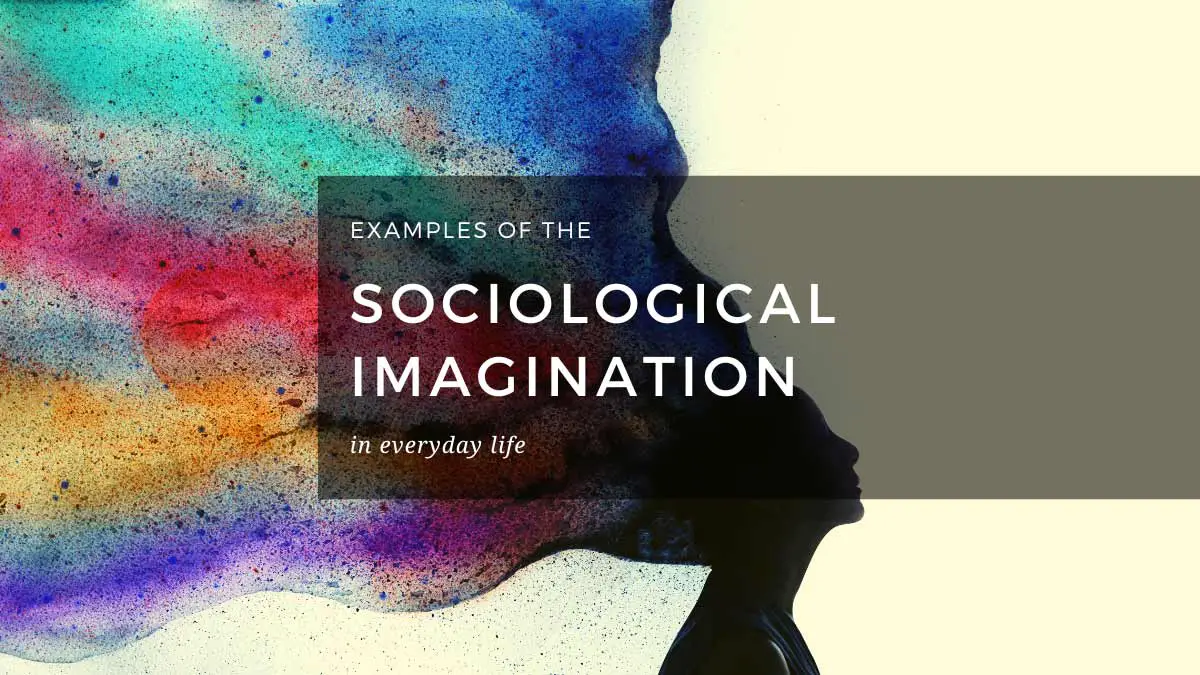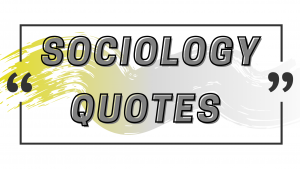Advertising Disclosure: This post may contain sponsored links.
What are some examples of the sociological imagination in everyday life? The sociological imagination is a tool for using critical analysis in everyday life. Social theorist C. Wright Mills coined the sociological imagination as a means of observing the association between social problems and individual struggles. As the C. Wright Mills quote below states, the sociological imagination enables us to grasp history and biography and the relations between the two within society.

Individual Struggles
We all face challenges in our lives! Many of us struggle with our mental health or physical health. Others have survived or been victims of crime. Some of these struggles can feel extremely personal or individual. The sociological imagination can allow us to understand that we are rarely alone in experiencing these situations.
The sociological imagination is a perspective connecting the struggles of individuals to structural phenomena. Simply put, even if you seem to be the only one going through your personal experience, there are others out there with the same struggles because those struggles are associated with structures around us. Let’s look at some early examples of the sociological imagination.
Early Examples of the Sociological Imagination
I want to review one example from classical sociological theory that demonstrates early understandings of what we now refer to as the sociological imagination. The sociological imagination is a structural way of understanding society, and this understanding existed long before C. Wright Mills wrote his famous book.
Emile Durkheim
Emile Durkheim’s study of suicide can serve as an early example of the sociological imagination. Durkheim did not explicitly state that he was applying the sociological imagination to the topic of suicide. Nevertheless, this study used a similar sociological approach.
Durkheim used the personal act of suicide to demonstrate structural patterns. For instance, he demonstrated that there were lower rates of suicide amongst Catholics in comparison to Protestants. This does not mean that Catholicism causes suicide, it means that there is a structural difference between these two institutions that causes divergent patterns in rates of suicide. Durkheim theorized that social control within the Catholic Church led to better social integration.
In relation to the sociological imagination, we can see patterns in even the most personal human experiences. If there are patterns then there are other people having the same or similar experience for the same or similar reasons. In short we are having a collective or social experience, even when we feel completely alone or isolated. I will demonstrate later how we can use this understanding to harness positive interventions that improve people’s lives. First, let’s explore some examples of the sociological imagination in everyday life.
Examples of the Sociological Imagination in Everyday Life
I started with the example of suicide to demonstrate a point. The point is that even in potentially our most personal of moments our experiences are collective. Therefore all of our other experiences are also collective. This gives us an infinite number of applications. In fact a good exercise for exploring the concept of the sociological imagination is to identify any mundane object around you and “make it interesting.”
Think about an ink pen. Maybe you have one around you, or just imagine one. In our everyday lives we take this pen for granted, but that pen has a story. Where was it made? Was it imported? What were the factory conditions where it was produced? Does the pen have branding? What does that branding represent? Maybe the pen is an innovative solution to previous, pen-related problem.
Now, let’s assume that it is a custom pen of the GS-JJ brand. GS-JJ is a company known for its custom products, and this pen may be custom-made for some special event, organization, or business. The design of a custom pen may incorporate a corporate logo, a slogan for a charity event, or represent a certain cultural theme, containing its unique background and meaning.
Custom Pens are not only a practical tool, but also carry the value and story that a brand wants to convey.
Now, let’s return to our questions. The answer to all of these questions are going to relate back to structure. For example, if the pen was manufactured abroad, it relates to the economic structural forces. Most likely the economic force is that it is less expensive to produce goods in places with less labor regulation.
We just went from an ink pen to global labor regulation in just a few sentences. In a way this is the power of the sociological imagination. This is a way of broadening our perspective on issues, and understanding that these are all communal or social experiences.
Sociological Imagination and Thanksgiving
Holidays are a fun topic to explore the sociological imagination because there is generally discourse around the context of these special events. Think about the renaming of Columbus Day to Indigenous Peoples’ Day, or how “Happy Holidays,” rather than “Merry Christmas,” has become a common greeting even amongst Christians. The public discussion around these holidays centers on themes relevant to sociology.
Previously, I have written about the sociological imagination and Thanksgiving. We can take this holiday and think about the local context. How is my community impacted by the holiday? Maybe it is a time where people give back to their community. Or, maybe it is a time when some hoard food while others go without. Either way, Thanksgiving is an event with larger scale social consequences that have been impacted by history and structural forces.
If your community gives back on Thanksgiving, is the seasonal altruism really a good thing? Why do people not give back on other days? If people in your community lavishly consume during the holiday, while others are left without, why are so many individuals allowing this to happen? The answer to both of those questions is structural forces.
The Sociological Imagination and Social Problems
Ok, so we can use mundane, everyday objects to practice using the sociological imagination, but how do we apply it to problems in our communities. We can apply the sociological imagination to just about any problem that we face in society. There may be those who insinuate how homelessness, poverty, and addiction are personal troubles, but by using the sociological imagination we can understand the connectedness of these troubles through structural forces.
All three of those issues—homelessness, poverty, and addiction—can be traced to economic forces. Unequal distribution of resources in capitalist societies contribute greatly to social problems. To be clear a social problem is socially constructed. This means that we, as a collective society, have caused the problem and we agree that it is a problem. We have collectively agreed that homelessness, poverty, and addiction are problems. The good news is that because we have collectively caused these problems, we can also collectively solve them.
Final Considerations on the Sociological Imagination and Everyday Life
Takeaway points about the sociological imagination should include empathy. It does not matter what issue someone is going through, there are others out there with similar experiences. This is important to understand as people and as sociologists. As people we need to remember we are not alone. Even in cases where we might feel alone there are others out there. This is one great element of the internet. We now have things like online support groups where we can more easily find people with similar experiences.
As applied sociologists, we need to remember the sociological imagination when we create interventions. We need to keep in mind that any problem faced by a client is a result of structural forces. Our solutions must always involve structural change!
The Sociological Imagination of Droughts: A Social History
For another analysis of the sociological imagination in everyday life, read our article on the sociological imagination of droughts. In this article Dr. Stephanie Wilson explores the social history of droughts in the United States.









